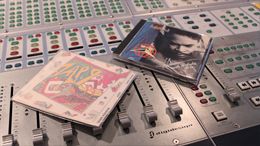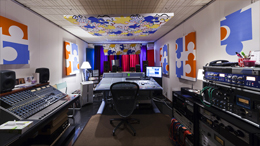The new talkbox sound
The gear Roger brought with him was pretty basic – a Minimoog and a JBL compression driver connected directly to a Bryston 4B power amp. I recall it had over 200 watts. I tried his setup a couple of times, and each time I was blown away by the sound level! He explained how he uses the minimoog's frequency controls to stabilize the pitch and that too much resonance would stiffen the sound. It was obvious he practiced a lot as there were marks near the knobs - probably so he wouldn't turn them too far. He is precise with his sound so he knows the best range.

David would constantly suggest new approaches during recording sessions. And one of his ideas was to record Emotions with a Prophet 5. I believe we also used an Oberheim Expander and Oberheim OB-X on different tracks. That’s how Roger recorded his talkbox polyphonically on Emotions (his first polyphonic talkbox recording was the 'shoo be too woo' on Computer Love) . That’s why it’s so special – especially Emotions. I still feel the mix of Roger’s funky guitar and tight rhythm & bass, combined with the beautiful harmony created by the polyphonic talkbox, is a miracle on its own.
The mixing engineer’s job
In "Break Through," we used the multi-band delay which is unique to the Lexicon PCM70. Roger was intrigued by it because he had never used anything like it before. The idea was based on the methods used to mix 12-inch records. Part of a mixing engineer's job is to use different effects to keep things interesting. This, back then, was a new and popular remix effect, and thus was not really necessary for R&B. Therefore, it was completely new to Roger. David’s urban production techniques, combined with my mix made Roger's sound truly striking. I believe it is one of the things that stands out most with Bridging the Gap.

It wasn’t common back then to receive a final master for mix-down. The artists would bring effects and keyboards to the studio and add to the track as it was mixed. It would be a lucky day if nothing had to be added. The recording process was relatively simple, but producers and artists would be constantly adding to the tracks until the mix was finalized. Effects weren’t applied through inserts as they are nowadays, but through busses on the console, which would be connected to dozens of effects laid out right next to each other. The mixing engineer would have to hit these bus buttons, in real-time, while the tracks were mixed. In many ways, the mixing engineer is also an artist.
|
|
The debate
Roger usually does everything on his own. That’s why he didn’t understand at first why I was called in to mix his tracks. He was convinced he needed no help. I remember clearly the "Get Up" mix session, where he and I were alone together. He would say, “Let me show you,” and make the mix so loud that I wanted to leave the room. Of course all the faders were up above zero and none were down. And he would ask me, “Mr. Goh, doesn’t this kick sound great? What do you think?” His mix wasn’t bad, but the master tracks were clipping already from the drums, while we still had over 30 tracks to mix – and there was no way we could balance them together! We ended up debating this for nearly two whole days. We were only two days from finishing the project and I almost lost patience with the process. In the end, though, it turned out to be a hilarious episode in how tracks are made.
I assume many R&B tracks back then were mixed the same way, and the levels had to be dropped at the very end, resulting in missing low frequencies. The reason tracks I mix have a nice low end is because every time anything is added, the lows are cut to make up for it. I only add low frequencies if they are needed.
Stories about Roger
There are so many stories about Roger, both inside and outside the studio. For example, he would dub a final mix to a cassette, and then walk around Santa Monica Boulevard playing for random pedestrians and asking them to tell him what they thought about the recording. Roger didn’t drive back then. He had given up on driving after he had been in an accident while he was concentrating on EQ-ing the car stereo. Later on, he fixed up an RV with a mixing console inside so he could sleep, travel and mix anywhere. People who love mixing can’t stop. The only problem was, again, everything was plus and none minus!

I briefly met him 2 or 3 years before he passed. I was at the Hilton in Japan when a white-suited Roger came up to me screaming, “Hey, Mr. Goh!” Unfortunately, that was the last time I saw him. I still clearly remember the debates we had during the production of Bridging the Gap. Roger was a type of person who never had to search for a conversation topic.
About Goh Hotoda :
Producer and mixing enginee. Most famous mixing engineer. Though spent career in Chicago, New York, Paris,Tokyo originally born in Tokyo, Japan. Also occasionally works as a producer and a remix producer.works include Grammy Awarded Chaka Khan, David Sanborn, Duran Duran, Janet Jackson, Madonna, Marcus Miller Prince, Sakamoto Ryuichi, Utada Hikaru and many other International artists. The works sold more than 58,000,000 copies worldwide. Now lives in JAPAN owns ICON D-control system based world class MIXING/MASTERING suite Accepting all the works from world wide via Internet will deliver the mix/multi format mix/DDP master/through out the world. (see ONLINE MIX/MASTERING SERVICE)
Official Site hotoda.com/en
Photo : Daisuke Kurihara and GF WORKS
|
|
|


